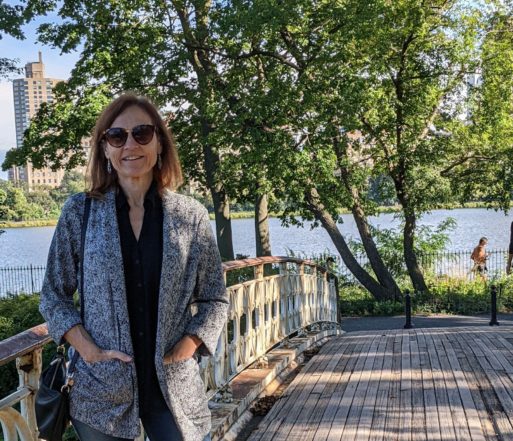
Dr. Bonnie Gorscak taking a brief break from her professional role
Intense sadness is to be expected after someone experiences the death of someone close to them. Those who are grieving and their friends and family may wonder when the pain will subside. There aren’t any easy answers for how people process loss; however, there are parameters for what typical grief looks like and when mourners might benefit from help.
For over three decades, Dr. Bonnie Gorscak, who serves as senior trainer at the Center for Prolonged Grief at Columbia School of Social Work, has provided psychotherapy to adults dealing with anxiety, grief/loss, depression, relationship and self-esteem issues. During our interview, Dr. Gorscak gives insight into the prolonged grief disorder (PGD) diagnosis, treatment and prognosis.
Editor’s note: This interview has been edited for length and clarity.
How do professionals define prolonged grief, and how does it differ from common grief?
Prolonged Grief Disorder (PGD), which was formerly referred to as Complicated Grief, is a persistent form of grief that, (according to the DSM 5-TR) continues for at least a year since the loss, in an unrelenting way, where the bereaved person suffers from intense yearning and longing for the person who died, along with other distressing feelings, often leaving them cut off from others and unable to move forward in their life. We consider a diagnosis of PGD when the bereaved person experiences persistent pervasive yearning, longing or preoccupation with the person who died that lasts at least a year and is beyond what is expected by the person’s social, cultural and religious groups, and to an extent that disrupts their life.
Grief is the natural response to a meaningful loss. It involves a natural disruption in our physical, psychological, social and interpersonal lives; it affects our sense of our self, and it often comes with many changes and challenges in several areas of our lives. Grief is permanent, it doesn’t go away. However, there’s a flow to the grief, and eventually, it ebbs. While grief usually evolves and diminishes in intensity over time, for those experiencing prolonged grief, the pain of the loss continues to be raw, as it was those first few days, weeks or months. It can persist like this for years or even decades. This is different from the natural upheaval in grief emotions that can occur around meaningful dates, such as holidays, anniversaries and birthdays.
What types of people are more likely to experience prolonged grief?
People who have pre-existing conditions, such as mental health struggles like depression or anxiety, may be predisposed to PGD. Also, people who have experienced multiple losses or previous trauma may be at a higher risk.
There are also risk factors that concern the death itself. For instance, if it was a violent death, and we include suicide in that category, or a sudden death, such as a car accident, those circumstances increase risk for PGD. The death of a child is extremely difficult and increases the chance that parents will have PGD and need help in coping and adapting. Certain circumstances surrounding how the person died, such as with COVID-19 deaths, involved risk factors. There were many situations during the pandemic, where the person died alone, it was sudden and family members were not allowed to be with them. Bereaved family members were left with questions about how the deceased contracted the virus, if they were to blame, and what more they could or should have done. While these are understandable questions and reactions to have, if the person can’t find a way to come to terms with their concerns, they may struggle with PGD.
What is the treatment for prolonged grief?
The treatment developed by Dr. M. Katherine Shear and her team, of which I’ve been fortunate to be a part of since 2001, aims to help the person to accept the reality of the loss, with all that it entails, and to restore a sense of well-being in life, while having an ongoing sense of connection with the person who died. And while no one ever fully accepts the loss of someone close, insofar as we certainly don’t want it to have happened, we do have a way of adapting to the fact that they are absent from our lives while still holding them close to us, as we look forward to the future with some sense of meaning, purpose and even joy.
Prolonged Grief Disorder Therapy or PGDT helps people adapt to a loss through what we call milestones. For instance, understanding what their grief involves and accepting the challenging emotions that come along with it, being able to strengthen and build relationships, learning to live with reminders and memories, and feel an ongoing sense of connection with the person who died. These are just a few of the milestones that naturally occur when grief evolves. We don’t think about grief in terms of stages. We now understand that grief evolves and transforms even as it continues to surge up at times and to subside at other times. As grief moves along naturally, it typically won’t look like it did in the first weeks or months after the death. For those experiencing PGD, we help their grief to soften, allowing for it to intensify at times, but finding its natural place in their life.
PGDT offers ways to help people to accept and manage the difficult emotions that come with grief. For example, early on during acute grief, bereaved people naturally move away from experiencing too many reminders of the reality of the death all at once, so that they can cope with and manage the inevitably overwhelming bouts of painful emotion. But with PGD, some of these natural ways of coping, like avoiding too many reminders, can start to dominate and then are no longer as helpful, but instead, leave the person feeling stuck in their grief. Even positive emotions can be challenging when people struggle with PGD. It can be difficult to allow positive emotions to come, as with “survivor’s guilt.” It can feel “wrong” to remain here or enjoy life when a dear loved one is no longer here. And while this is an understandable and natural feeling early on in grief, it can interfere if it becomes too prominent and persists years later.
We also encourage people to build and nurture the relationships in their life. People don’t grieve well alone. One of the hallmarks of PGD is that it can be difficult to accept support because the person feels disconnected from the world. Their pain may make them feel isolated. By reaching out and allowing others to reach them, they can re-enter the world. Practicing self-care and self-compassion can help people transition to being hopeful about the future.
Losing someone close is one of the most stressful, painful experiences in life. And even though grief lasts forever, we do not or would not try to take that pain away, since it is a form of our love. Rather, this treatment focuses on alleviating the additional suffering that PGD adds to the challenges of grieving. It’s very rewarding work to be able to help people this way, in situations where we might otherwise feel helpless to do anything.
When should we be concerned about ourselves or others as it pertains to experiencing prolonged grief?
If someone seems to be suffering, it’s not a question of if they are grieving too much or for too long. Grief is unique to each relationship, so everyone grieves each loss differently. So, just noticing that someone is still grieving, even intensely, long after the death occurred, is not a sign of PGD, unless the intense grief is persistent and pervasive and interfering with their ability to feel any sense of well being. Of course it’s always good to offer support to a grieving person.
Additionally, there is always reason for concern if a bereaved person is engaging in self-destructive behaviors, such as relying on drugs or alcohol, not taking their prescribed medicine, or ignoring their own needs for self-care.
As time goes on, most bereaved people, even those who are still clearly grieving, are able to gradually take more interest in their daily lives, attend to their health by sleeping and eating well, and engage with others and move about the world freely. And with more time, they are able to get involved in former activities or new ones, and make plans for the future. They are comfortable talking about the person who died and sharing memories, even though they’re bittersweet.
How can we help someone who may be experiencing prolonged grief?
“Grief is the form love takes when our loved one dies.” – Dr. Katherine Shear
At the Center for Prolonged Grief at Columbia School of Social Work, we talk about how grief is a form of love. We understand grief through the lens of attachment theory, which tells us about the importance of close relationships. Because those we are close to have such an enormous impact on us, when they die, that relationship has to change, that love has to transform. We re-learn how to feel close and honor them and how to continue to feel a connection with them though they no longer exist in this world.

Credit: Dr. Bonnie Gorscak
Remember to be very patient with those who are grieving, especially those who might be struggling with prolonged grief. Those with PGD sometimes hear that they need to just move on or get over their loss. They can feel frustrated with themselves, and those close to them can become frustrated, as well. While you can encourage or invite people to do things, it is helpful to remember they’re not suffering on purpose. It can be challenging to be patient, but offering kindness not just during the early difficult times, but long after a loss occurred, can be greatly appreciated. Asking for permission can also be a great doorway to helping them. You can ask for permission to voice your concerns or give options for help. You can ask for permission to talk about the deceased or share positive memories. You can also ask them to do things, either with you or for you, such as going for a walk, or perhaps, “would you like to teach me to cook that favorite meal of mine that you make so well”—while recognizing that they may or may not feel up to it at any given time. Letting those who are grieving know that you still need them, that they’re still important to you and who they are is still valuable to you, may help them re-enter the world.
For additional information and resources visit prolongedgrief.columbia.edu

 How Does Prolonged Grief Differ From Common Grief?
How Does Prolonged Grief Differ From Common Grief?



 “Songbird” by Fleetwood Mac
“Songbird” by Fleetwood Mac
 First the Wealth Gap, Now the U.S. Has a Growing Health Gap
First the Wealth Gap, Now the U.S. Has a Growing Health Gap















